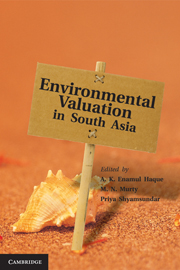Book contents
- Frontmatter
- Contents
- List of Figures
- List of Tables
- List of Appendices
- List of Contributors
- Preface
- Chapter 1 Introduction
- Chapter 2 Environmental Valuation: A Review of Methods
- Chapter 3 Valuing the Environment as a Production Input
- Chapter 4 Should Shrimp Farmers Pay Paddy Farmers?: The Challenges of Examining Salinization Externalities in South India
- Chapter 5 Evaluating Gains from De-Eutrophication of the Dutch Canal in Sri Lanka
- Chapter 6 Pesticide Productivity and Vegetable Farming in Nepal
- Chapter 7 Forests, Hydrological Services, and Agricultural Income: A Case Study from the Western Ghats of India
- Chapter 8 Can Mangroves Minimize Property Loss during Big Storms?: An Analysis of House Damages due to the Super Cyclone in Orissa
- Chapter 9 Valuation of Recreational Amenities from Environmental Resources: The Case of Two National Parks in Northern Pakistan
- Chapter 10 Valuing the Land of Tigers: What Indian Visitors Reveal
- Chapter 11 Estimating Welfare Losses from Urban Air Pollution using Panel Data from Household Health Diaries
- Chapter 12 Children in the Slums of Dhaka: Diarrhoea Prevalence and its Implications
- Chapter 13 Red Wells, Green Wells and the Costs of Arsenic Contamination in Bangladesh
- Chapter 14 Air Quality and Cement Production: Examining the Implications of Point Source Pollution in Sri Lanka
- Chapter 15 Revisiting the Need for Improved Stoves: Estimating Health, Time and Carbon Benefits
- Chapter 16 Benefits from Reduced Air Pollution in Delhi and Kolkata: A Hedonic Property Price Approach
- Chapter 17 The Value of Statistical Life
- Chapter 18 An Assessment of Demand for Improved Household Water Supply in Southwest Sri Lanka
- Index
Chapter 8 - Can Mangroves Minimize Property Loss during Big Storms?: An Analysis of House Damages due to the Super Cyclone in Orissa
Published online by Cambridge University Press: 05 November 2012
- Frontmatter
- Contents
- List of Figures
- List of Tables
- List of Appendices
- List of Contributors
- Preface
- Chapter 1 Introduction
- Chapter 2 Environmental Valuation: A Review of Methods
- Chapter 3 Valuing the Environment as a Production Input
- Chapter 4 Should Shrimp Farmers Pay Paddy Farmers?: The Challenges of Examining Salinization Externalities in South India
- Chapter 5 Evaluating Gains from De-Eutrophication of the Dutch Canal in Sri Lanka
- Chapter 6 Pesticide Productivity and Vegetable Farming in Nepal
- Chapter 7 Forests, Hydrological Services, and Agricultural Income: A Case Study from the Western Ghats of India
- Chapter 8 Can Mangroves Minimize Property Loss during Big Storms?: An Analysis of House Damages due to the Super Cyclone in Orissa
- Chapter 9 Valuation of Recreational Amenities from Environmental Resources: The Case of Two National Parks in Northern Pakistan
- Chapter 10 Valuing the Land of Tigers: What Indian Visitors Reveal
- Chapter 11 Estimating Welfare Losses from Urban Air Pollution using Panel Data from Household Health Diaries
- Chapter 12 Children in the Slums of Dhaka: Diarrhoea Prevalence and its Implications
- Chapter 13 Red Wells, Green Wells and the Costs of Arsenic Contamination in Bangladesh
- Chapter 14 Air Quality and Cement Production: Examining the Implications of Point Source Pollution in Sri Lanka
- Chapter 15 Revisiting the Need for Improved Stoves: Estimating Health, Time and Carbon Benefits
- Chapter 16 Benefits from Reduced Air Pollution in Delhi and Kolkata: A Hedonic Property Price Approach
- Chapter 17 The Value of Statistical Life
- Chapter 18 An Assessment of Demand for Improved Household Water Supply in Southwest Sri Lanka
- Index
Summary
Introduction
Mangrove forests provide a range of ecosystem services to humans (Dixon, et al., 1994; MEA, 2003). Among these services, storm protection remains one of the most important regulating services provided by mangroves. During storms, mangroves provide protection to inland properties and lives by reducing wind and storm surge velocity. Given recent increases in the frequency of cyclones and the fear of further increases in frequency and intensity due to climate change (Steffen, 2006), both research and quantification of the storm protection function of mangroves becomes important.
Since the Indian Ocean Tsunami of December 2004, the protection services of coastal forests have been in the limelight. Though some anecdotal reports and studies have concluded that the presence of mangroves reduced the extent of tsunami damage (UNEP, 2005; Danielson et al., 2005; Kathiresan and Rajendran, 2005; Dahdouh-Guebas et al., 2006), critics have questioned their validity citing limited sample size and inappropriate statistical analysis (Kerr et al., 2006; Baird, 2006). Some researchers see coastal forests as playing either a marginal or no role in containing tsunami damages and have underscored the need for clearer answers (Kerr and Baird, 2007; Chatenox and Peduzzi, 2007; Cochard, R. et al., 2008). Theoretically, it is well established that mangroves can reduce cyclone impact by dissipating wave energy (Mazda et al., 1997, 2006; Brinkman et al., 1997; Massel et al., 1999; Hamza et al., 1999; Harada and Imamura, 2005; Quartel et al., 2007). But there is little in the way of detailed empirical work (Khazai et al., 2007).
- Type
- Chapter
- Information
- Environmental Valuation in South Asia , pp. 170 - 210Publisher: Cambridge University PressPrint publication year: 2011
- 4
- Cited by



